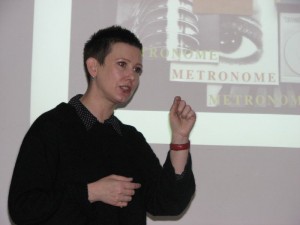WORLD OF ART
Laboratorium of Curatorial Practices
Season 10: 2006/07
Series of Lectures on Curatorial and Institutional Practice
Tuesday, February 6, 2007, at 19.00
Cankarjev dom, M3/4 Hall, Prešernova 10, Ljubljana
In her lecture, Clémentine Deliss focused on conclusions that she has reached through creating the magazine Metronome, a project she has developed as a kind of research practice that resisted the dominating forms of exhibitions and curatorial work in the field of contemporary visual arts. This work has led her to become engaged in the frame of art academies in recent years which, in turn, stimulated her interest in the possibilities of establishing a Future academy. Clémentine has conceived her Future academy mostly within different artistic institutions in which she has worked and throughout the entire four years of this research project. This is not, in fact, an actual project of school that would take place in real space and in a brief time span; it is rather a deliberation and research on ways, contents and structures that make sense when we think in the first place on such matters. After all the years of research and confrontation with various methods of work within different academic structures, Clémentine has come up with some rather remarkable conclusions and questions that she formulated in three segments for the purpose of this lecture:
1. The cartography of mobility.
What is mobility in art research and practice? Is it classical romanticism or neo-liberal policy to believe in a mobile, peripatetic faculty of arts? If not what is required to make itinerant academies into a reality? What can we learn from the conceptual and organisational make-up of recent small-scale associations or artist-led collectives? Do these present cases for increased localization or for mobility? Is sustainability actually possible with a mobile faculty of arts or do we need to conceive of impermanency and informal economic parameters as part of the productivity of a new structure? Who can be the host of a mobile faculty of arts?
2. The positions of artist and curator as polymathic agents.
What is the polymath in today’s world? How do curators negotiate specificity and multiplicity in the way they choose to work with artists and audiences? How do we assess the artist’s articulation of a combination of activities that include private gallery shows, increased participation in large-scale international events, and ‘activist’ education? Why are artists interested in the question of education and what is the current fuss around research? Under what conditions can art colleges and universities generate autonomous dynamics of practice and production?
3. Defining future faculties of knowledge.
What is a faculty of knowledge? Is it a person, a skill to be learnt, or a discipline that evokes relations of power? Do we shy away from naming members of new academy of competence in art practice and art theory in favor of neutralized and semi-abstract definitions? What formulations and methodologies of knowledge production travel across cultural and disciplinary borders? Who or what shifts knowledge from one place to another? What forms of knowledge and art practice do not travel or translate and why? Is there confusion between the private and the social, or the covert and the public within our concept of future faculties of knowledge? What role do curators play today, fifteen years after the ‘global art’ surge?
A transcript (pdf, 161KB) of the public presentation of A Project for Mobile Art School, Cankarjev dom, February 11, 2007.
Clémentine Deliss’ public lecture was the introduction to the workshop with the participants chosen through a public competition or through their previous attendance of Performing Arts Seminar (Maska) or World of Art – the School for Contemporary Art (SCCA-Ljubljana).
